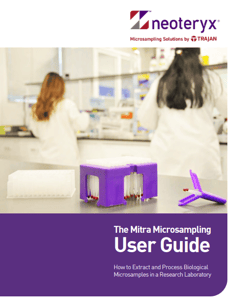microsampling in toxicology
Are you a toxicologist, healthcare provider, or clinical lab manager seeking an efficient solution for blood sample collection and screening? Look no further. Our microsampling devices and kits can provide convenient collection for development of your toxicology screening or program!
Microsampling for Drug Testing & Monitoring
Remotely collected dried capillary blood samples have been used successfully for a range of toxicology and drug monitoring studies. In many cases, dried blood microsamples can replace the use of urine samples for test results that are highly sensitive and specific.
Whether you are a physician monitoring patients' blood samples to ensure the efficacy of a therapeutic drug or you are a toxicologist screening blood samples for drug or alcohol abuse related to addiction recovery, traffic control, or child custody cases, finger-stick blood samples can provide convenient portability and analytical precision.
Frequently Asked Questions (FAQs)
Yes, microsampling devices based on volumetric technology have been used in toxicology programs to study drugs of abuse and environmental health, among other areas. It would be good to see wider adoption in the field of Clinical Toxicology where it could be applied for greater benefit, though microsampling applications in that field are on the rise. Our Technical Resource Library includes a searchable selection of published literature from some scientists who have overcome barriers and successfully applied remote specimen collection and volumetric microsampling. Type "toxicology" or your analyte of interest in the library's search field to find journal articles, presentations and application notes.
Toxicology labs have used microsampling devices to study Phosphatidylethanol (PEth), a highly sensitive and specific blood marker of alcohol consumption. PEth lacks stability in liquid blood, but dried blood microsampling has been identified as an accurate, cheaper alternative that solves the stability issue. Other analytes or biomarkers of keen interest in microsampling studies are opioids, cannabinoids, performance-enhancing drugs, narcotics, and peptides, among others.
Yes, many analytes have been extracted using volumetric microsampling, and are compatible with hemaPEN® and Mitra® devices with VAMS® technology. Type your analyte of interest in the Technical Resource Library search field to find out more about the analytes that others have investigated using microsampling.
Toxicology, antidoping and addiction recovery programs often use urine samples to screen for certain substances. However, many substances are less detectable in urine than they are blood. With dried blood samples, researchers and labs can detect many substances with high sensitivity and specificity. Many analytes will remain stable in a dried blood matrix, while liquid blood in a test tube can degrade over time. To read published journal articles and presentations describing how toxicologists use dried blood microsamples in their work, please visit our Technical Resource Library.
Sample success rates are high for Mitra® and hemaPEN® devices, which are based on volumetric microsampling. The absorptive VAMS® tips on Mitra can absorb homogenous samples with 99% acceptance rates.*
By following the illustrated instructions and demo videos available with hemaPEN and Mitra, end-users can reliably collect fixed volume samples that are precise enough for lab analysis.
These volumetric microsampling devices overcome the hematocrit (HCT) bias that may occur with DBS cards, where non-homogenous blood spots on filter paper have higher variability and higher failure rates.*
*Data on sample success rates are discussed in published research articles in our online Microsampling Resource Library.
Example: https://www.medrxiv.org/content/10.1101/2021.01.27.21250570v1.full
Evaluation: Extraction, linearity & signal-to-noise studies
Validation: Validating your method
 Microsampling User Guide
Microsampling User Guide
This technical user guide is designed to get you started with microsampling. The printed guidance from our technical director helps you make initial decisions on best practices for achieving solid analytical validations in your research projects. What microsample volume is needed for your assay? What analyte classes are compatible with microsampling? How do you process microsamples in the lab? Download the guide to find answers to these questions, and more!
Toxicology Blog Listing
Read through our selection of blogs to learn about all the different ways that microsampling is being applied in toxicology research, therapeutic drug monitoring (TDM), and related studies and programs. Click the button below to explore our blogs on toxicology, TDM and related topics, gathered together in a single listing.
Microsampling in Toxicology: Interview
Listen to toxicologists from Ghent University in Belgium, Professor Christophe Stove, PhD, and Katleen Van Uytfanghe, PhD, discuss some of the microsampling study papers they have co-authored. Much of their work is focused on detecting the alcohol biomarker PEth, or phosphatidylethanol, in blood microsamples.
Gain Access to the Microsampling Resource Library!
How do others use microsampling in toxicology and therapeutic drug monitoring programs? For answers, fill out the form to gain access to our Microsampling Resource Library, where you can find materials by selecting either the resource type, key topic, assay or by typing your topic of interest in the general search field.


